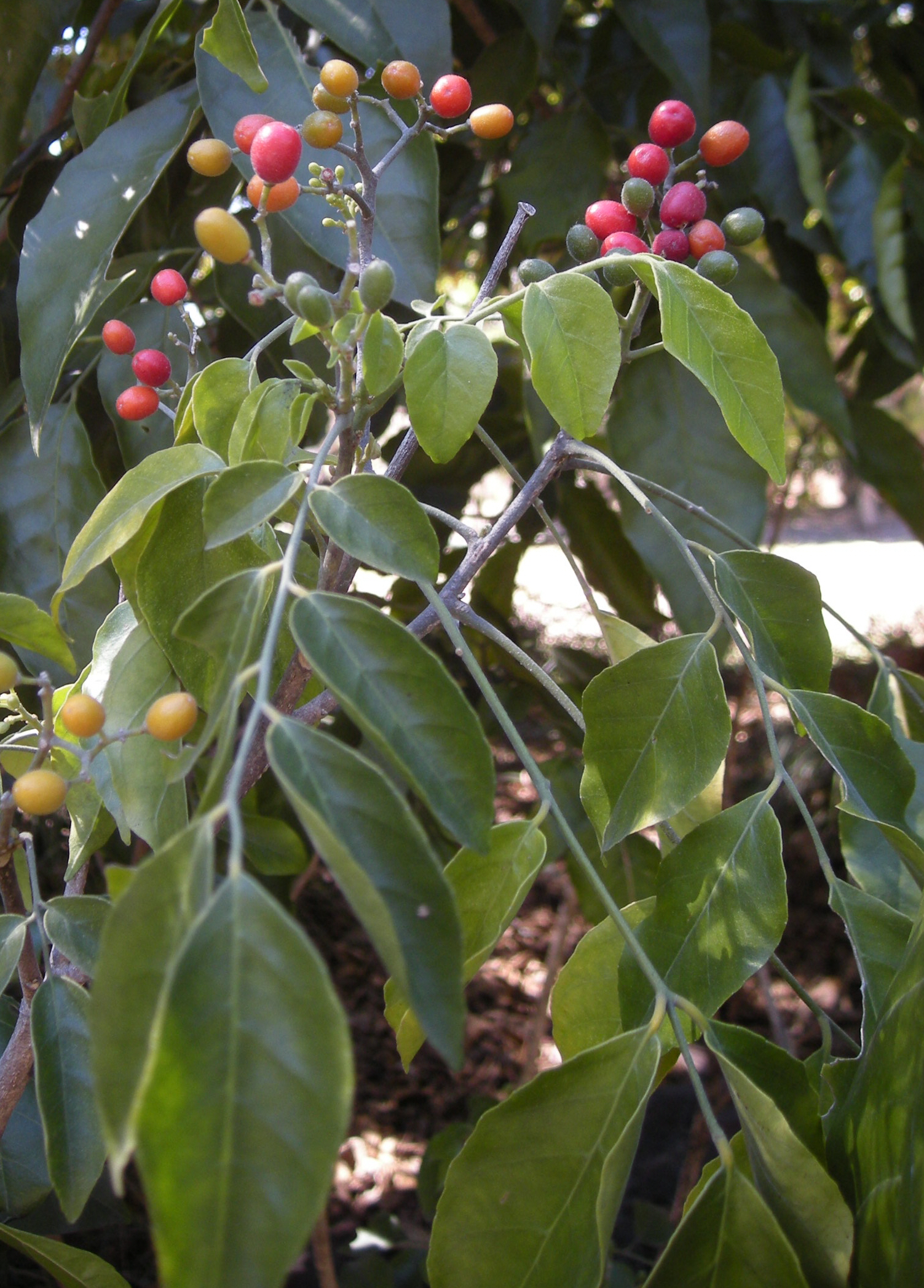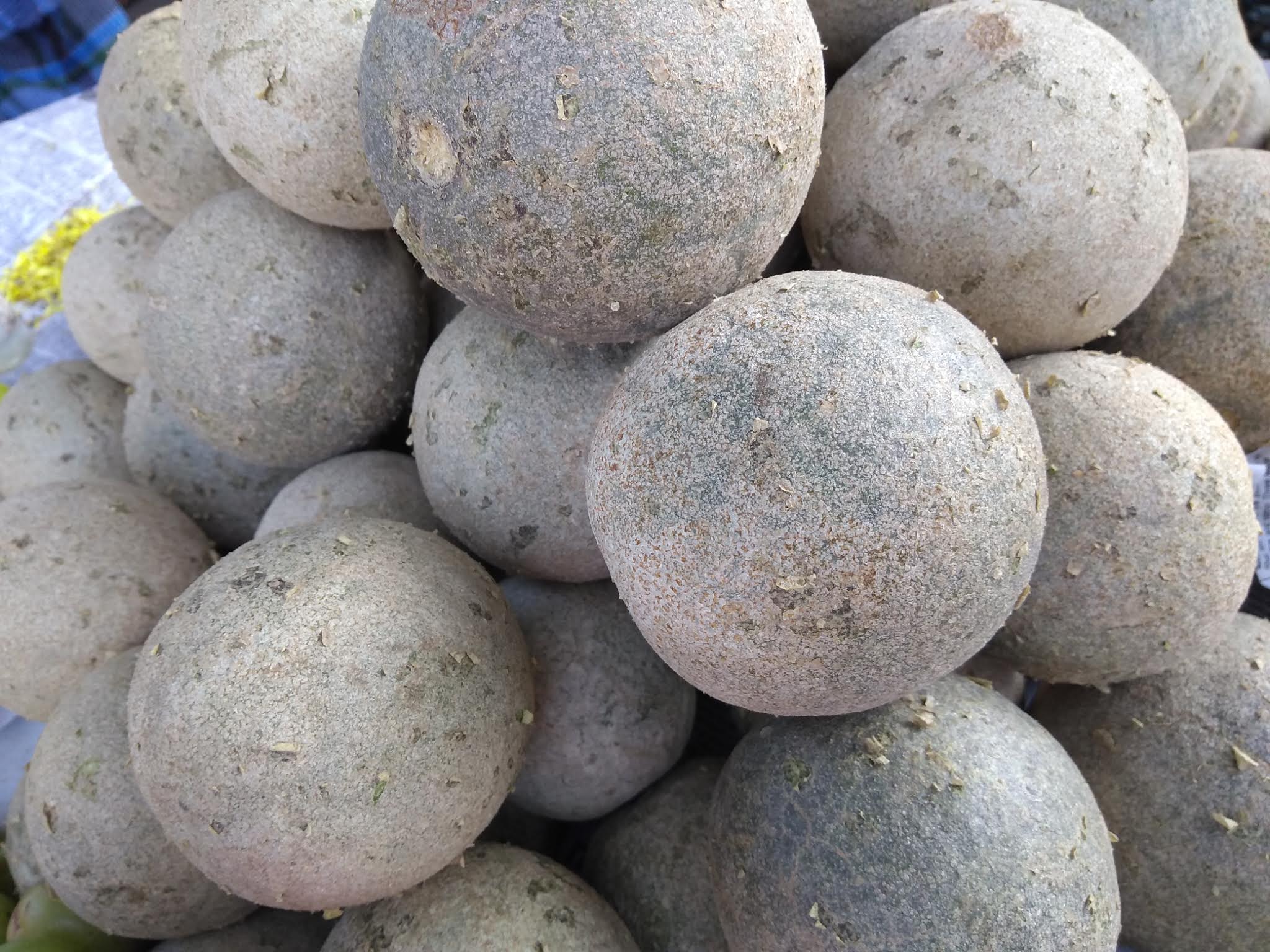|
Feroniella Lucida
''Feroniella'' is a genus in the family Rutaceae, the only species being ''Feroniella lucida''. The genus is placed within ''Citrus'' by some sources, with the species becoming ''Citrus lucida''. ''Feroniella lucida'' is a fruit-bearing tree native to Cambodia, Laos, Thailand, Vietnam and the island of Java, Indonesia. Description ''Feroniella lucida'' is a small to medium-sized tree armed with numerous long, slender, sharp thorns. It grows from tall with a straight bole in diameter. The fruit has a tough green rind with a white and pink pulp containing many yellow crunchy seeds. Taxonomy The species was initially treated as a member of the genus ''Feronia'', but was removed to its own genus, ''Feroniella'', by Swingle, who viewed it to be a sister taxon of '' Limonia'' in a grouping given the common name of 'wood apples'. He also named ''Feroniella oblata'' to distinguish the Cambodian from the Javanese plants, but they came to be viewed as varieties of the same species, ''Fe ... [...More Info...] [...Related Items...] OR: [Wikipedia] [Google] [Baidu] |
Genus
Genus ( plural genera ) is a taxonomic rank used in the biological classification of extant taxon, living and fossil organisms as well as Virus classification#ICTV classification, viruses. In the hierarchy of biological classification, genus comes above species and below family (taxonomy), family. In binomial nomenclature, the genus name forms the first part of the binomial species name for each species within the genus. :E.g. ''Panthera leo'' (lion) and ''Panthera onca'' (jaguar) are two species within the genus ''Panthera''. ''Panthera'' is a genus within the family Felidae. The composition of a genus is determined by taxonomy (biology), taxonomists. The standards for genus classification are not strictly codified, so different authorities often produce different classifications for genera. There are some general practices used, however, including the idea that a newly defined genus should fulfill these three criteria to be descriptively useful: # monophyly – all descendants ... [...More Info...] [...Related Items...] OR: [Wikipedia] [Google] [Baidu] |
Chōzaburō Tanaka
, often Romanized as Tyôzaburô Tanaka (November 3, 1885 in Osaka – June 28, 1976), was a Japanese botanist and mycologist. He established one of the two major taxonomic classification systems for citrus and related genera currently in use, and is now considered to be a taxonomic " splitter". He is the author of 180 botanical names in the citrus family Rutaceae, [...More Info...] [...Related Items...] OR: [Wikipedia] [Google] [Baidu] |
Aurantioideae Genera
Aurantioideae (sometimes known as Citroideae) is the subfamily within the rue and citrus family (Rutaceae) that contains the citrus. The subfamily's center of diversity is in the monsoon region of eastern Australasia, extending west through South Asia into Africa, and eastwards into Polynesia. Notable members include citrus (genus ''Citrus''), bael (''Aegle marmelos''), curd fruit (''Limonia acidissima''), species of genus ''Murraya'' such as curry tree (''M. koenigii'') and orange jessamine (''M. paniculata''), and the small genus ''Clausena''. Description Aurantioideae are smallish trees or large shrubs, or rarely lianas. Their flowers are typically white and fragrant. Their fruit are very characteristic hesperidia, usually of rounded shape and colored in green, yellowish or orange hues. Taxonomy The subfamily has been divided into two tribes, the ancestral Clauseneae and the more advanced Citreae, as in a 1967 classification. A 2021 classification by Appelhans et al. bas ... [...More Info...] [...Related Items...] OR: [Wikipedia] [Google] [Baidu] |
Aurantioideae
Aurantioideae (sometimes known as Citroideae) is the subfamily within the rue and citrus family (Rutaceae) that contains the citrus. The subfamily's center of diversity is in the monsoon region of eastern Australasia, extending west through South Asia into Africa, and eastwards into Polynesia. Notable members include citrus (genus ''Citrus''), bael (''Aegle marmelos''), curd fruit (''Limonia acidissima''), species of genus ''Murraya'' such as curry tree (''M. koenigii'') and orange jessamine (''M. paniculata''), and the small genus ''Clausena''. Description Aurantioideae are smallish trees or large shrubs, or rarely lianas. Their flowers are typically white and fragrant. Their fruit are very characteristic hesperidia, usually of rounded shape and colored in green, yellowish or orange hues. Taxonomy The subfamily has been divided into two tribes, the ancestral Clauseneae and the more advanced Citreae, as in a 1967 classification. A 2021 classification by Appelhans et al. ba ... [...More Info...] [...Related Items...] OR: [Wikipedia] [Google] [Baidu] |
Lichexanthone
Lichexanthone is an organic compound in the structural class of chemicals known as xanthones. Lichexanthone was first isolated and identified by Japanese chemists from a species of leafy lichen in the 1940s. The compound is known to occur in many lichens, and it is important in the taxonomy of species in several genera, such as ''Pertusaria'' and ''Pyxine''. More than a dozen lichen species have a variation of the word lichexanthone incorporated as part of their binomial name. The presence of lichexanthone in lichens causes them to fluoresce a greenish-yellow colour under long-wavelength UV light; this feature is used to help identify some species. Lichexanthone is also found in several plants (many are from the families Annonaceae and Rutaceae), and some species of fungi that do not form lichens. In lichens, the biosynthesis of lichexanthone occurs through a set of enzymatic reactions that start with the molecule acetyl-CoA and sequentially add successive units, forming a longe ... [...More Info...] [...Related Items...] OR: [Wikipedia] [Google] [Baidu] |
Phytochemical
Phytochemicals are chemical compounds produced by plants, generally to help them resist fungi, bacteria and plant virus infections, and also consumption by insects and other animals. The name comes . Some phytochemicals have been used as poisons and others as traditional medicine. As a term, ''phytochemicals'' is generally used to describe plant compounds that are under research with unestablished effects on health, and are not scientifically defined as essential nutrients. Regulatory agencies governing food labeling in Europe and the United States have provided guidance for industry to limit or prevent health claims about phytochemicals on food product or nutrition labels. Definition Phytochemicals are chemicals of plant origin. Phytochemicals (from Greek ''phyto'', meaning "plant") are chemicals produced by plants through primary or secondary metabolism. They generally have biological activity in the plant host and play a role in plant growth or defense against competitors, p ... [...More Info...] [...Related Items...] OR: [Wikipedia] [Google] [Baidu] |
Indoor Bonsai
Indoor bonsai are bonsai cultivated for the indoor environment. Traditionally, bonsai are temperate climate trees grown outdoors in containers. Tropical and sub-tropical tree species can be cultivated to grow and thrive indoors, with some suited to bonsai aesthetics shaped as traditional outdoor or wild bonsai. Bonsai and related practices, like ''penjing'', ''hòn non bộ'', and ''saikei'', involve the long-term cultivation of small trees and landscapes in containers. The term ''bonsai'' is generally used in English as an umbrella term for all miniature trees in containers or pots. Indoor vs. traditional bonsai Indoor bonsai is the cultivation of an attractive, healthy plant in the artificial environment of indoors rather than using an outdoor climate, as may occur in traditional bonsai. Indoor penjing is the cultivation of miniature landscapes in a pot or tray, possibly with rocks, bonsai trees, and ground covers, and sometimes with small objects or figurines. Bonsai vs. ... [...More Info...] [...Related Items...] OR: [Wikipedia] [Google] [Baidu] |
Pericarp
Fruit anatomy is the plant anatomy of the internal structure of fruit. Fruits are the mature ovary or ovaries of one or more flowers. They are found in three main anatomical categories: aggregate fruits, multiple fruits, and simple fruits. Aggregate fruits are formed from a single compound flower and contain many ovaries or fruitlets. Examples include raspberries and blackberries. Multiple fruits are formed from the fused ovaries of multiple flowers or inflorescence. Examples include fig, mulberry, and pineapple. Simple fruits are formed from a single ovary and may contain one or many seeds. They can be either fleshy or dry. In fleshy fruit, during development, the pericarp (ovary wall) and other accessory structures become the fleshy portion of the fruit. The types of fleshy fruits are berries, pomes, and drupes. In some fruits, the edible portion is not derived from the ovary, but rather from the aril, such as the mangosteen or pomegranate, and the pineapple from which tissue ... [...More Info...] [...Related Items...] OR: [Wikipedia] [Google] [Baidu] |
Plants Of The World Online
Plants of the World Online (POWO) is an online database published by the Royal Botanic Gardens, Kew. It was launched in March 2017 with the ultimate aim being "to enable users to access information on all the world's known seed-bearing plants by 2020". The initial focus was on tropical African Floras, particularly Flora Zambesiaca, Flora of West Tropical Africa and Flora of Tropical East Africa. The database uses the same taxonomical source as Kew's World Checklist of Selected Plant Families, which is the International Plant Names Index, and the World Checklist of Vascular Plants (WCVP). POWO contains 1,234,000 global plant names and 367,600 images. See also *Australian Plant Name Index *Convention on Biological Diversity *World Flora Online *Tropicos Tropicos is an online botanical database containing taxonomic information on plants, mainly from the Neotropical realm (Central, and South America). It is maintained by the Missouri Botanical Garden and was established over 25 y ... [...More Info...] [...Related Items...] OR: [Wikipedia] [Google] [Baidu] |
David Mabberley
Professor David John Mabberley , (born May 1948) is a British-born botanist, educator and writer. Among his varied scientific interests is the taxonomy of tropical plants, especially trees of the families Labiatae, Meliaceae and Rutaceae. He is perhaps best known for his plant dictionary ''The plant-book. A portable dictionary of the vascular plants''. The third edition was published in 2008 as '' Mabberley's Plant-book'', for which he was awarded the Engler Medal in Silver in 2009. As of June 2017 '' Mabberley's Plant-book'' is in its fourth edition. Biography Born in Tetbury, Gloucestershire, England, Mabberley won a scholarship to Rendcomb College, Cirencester, then an open scholarship to St Catherine's College, Oxford, where he graduated B.A. in 1970 and M.A. in 1974. Although he intended to work for a doctorate under the cytologist C. D. Darlington he was inspired to move to Sidney Sussex College, Cambridge, under the supervision of E. J. H. Corner, leading to a PhD in ... [...More Info...] [...Related Items...] OR: [Wikipedia] [Google] [Baidu] |
Limonia Acidissima
''Limonia acidissima'' is the only species within the monotypic genus ''Limonia''. Common names for the species in English include wood-apple and elephant-apple. It is sometimes also called monkey fruit. Description ''Limonia acidissima'' is a large tree growing to tall, with rough, spiny bark. The leaves are pinnate, with 5-7 leaflets, each leaflet 25–35 mm long and 10–20 mm broad, with a citrus-scent when crushed. The flowers are white and have five petals. The fruit is a berry 5–9 cm diameter, and may be sweet or sour. It has a very hard rind which can be difficult to crack open, it appears greenish-brown in colour from outside and contains sticky brown pulp and small white seeds. The fruit looks similar in appearance to the Bael fruit ''(Aegle marmelos)''. It contains considerable amount of protein, carbohydrate, iron, fat, calcium, Vit-B & C etc. 100 g of ripe fruit pulp contains up to 49 KCal. Taxonomy A number of other species formerly included ... [...More Info...] [...Related Items...] OR: [Wikipedia] [Google] [Baidu] |
Rutaceae
The Rutaceae is a family, commonly known as the rueRUTACEAE in BoDD – Botanical Dermatology Database or family, of s, usually placed in the order . Species of the family generally have s that divide into four or five parts, usually w ... [...More Info...] [...Related Items...] OR: [Wikipedia] [Google] [Baidu] |


.jpg)



